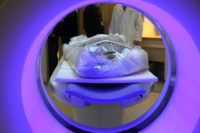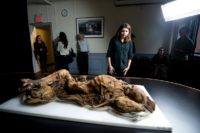 Researchers have discovered evidence of heart disease in five mummies from 16th-century Greenland. An international team of anthropologists, medical doctors and technicians examined the mummies with a Computed Tomography scanner in the Brigham and Women’s Hospital (BWH) Shapiro Cardiovascular Center last year. They were looking for arterial plaque, the material that lines the arteries, hardening and narrowing them and creating blockages that can result in fatal heart attacks and strokes.
Researchers have discovered evidence of heart disease in five mummies from 16th-century Greenland. An international team of anthropologists, medical doctors and technicians examined the mummies with a Computed Tomography scanner in the Brigham and Women’s Hospital (BWH) Shapiro Cardiovascular Center last year. They were looking for arterial plaque, the material that lines the arteries, hardening and narrowing them and creating blockages that can result in fatal heart attacks and strokes.
Atherosclerosis and the cardiovascular disease that result from it is the leading cause of death in the U.S. today. The research team wanted to find out if it was common 500 years ago in Greenland, part of a larger project investigating the heart health of mummified human remains from pre-industrial hunter-gatherer communities.
 The mummies of four young adults and one child from the Inuit community in 16th century Greenland were subjected to high-resolution CT scans. The organs were not intact inside the bodies, but even without hearts to explore, researchers were able to detect hardened calcium, ie plaque, in the remains of blood vessels in the chest and neck.
The mummies of four young adults and one child from the Inuit community in 16th century Greenland were subjected to high-resolution CT scans. The organs were not intact inside the bodies, but even without hearts to explore, researchers were able to detect hardened calcium, ie plaque, in the remains of blood vessels in the chest and neck.
From Egypt to Mongolia and now Greenland, mummies throughout the ages have shown evidence of atherosclerosis. The Greenland mummies were of particular interest due to their diet, which would have primarily consisted of fish and sea mammals.
While increased fish consumption is commonly touted as heart-healthy — which may make the findings of atherosclerosis seem surprising — [associate director of the Brigham’s Cardiovascular Imaging Program Dr. Ron] Blankstein emphasized that scientists still have much to learn about its relationship to cardiovascular health. For example, although it is known that consuming fish rich in omega-3 fats has benefits, some types of fish can also be high in cholesterol and, in the current era, contain toxins like mercury or polychlorinated biphenyls (PCBs) that may pose risk, he said.
Lifestyle factors, such as exposure to cooking smoke in their dwellings, may have also contributed to the mummified individuals developing cardiovascular disease during their lifetimes, Blankstein said. Given that and the small sample sizes of these mummy scans, he noted that the team’s findings shouldn’t be taken too much to heart, so to speak.